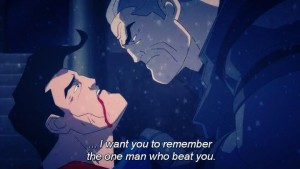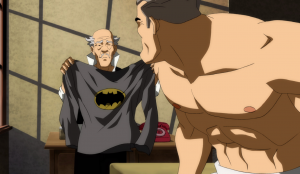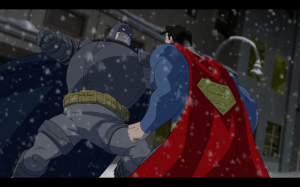One of my all time favourite Batman comics is Frank Miller’s Dark Knight Returns. In 2012, the 1986 comic was adapted into an animated film split into 2 parts to great acclaim and raving reviews. Its mirror like reflection of the comic ensure the majority of Batman fans enjoyed it. I certainly did.
What was really compelling in my mind were the struggles an older Bruce Wayne faced after being in retirement for over a decade. We see a man who has built a symbol of hope over decades serving justice. As time progresses, Bruce must deal with getting older, a battered body that’s been sacrificed for the people of Gotham over time. Bruce sees the transition of time, and how his city has changed, and the meaning of the “Batman” is up for debate amongst the people. More importantly for Bruce the inevitable decay of the body and mind over time and the desire to recapture what Bruce, and we, once was accustomed to. Being the Batman and maintaining order and control. It’s no longer the case.
There are some particular sequences in the animated film that really struck me, both in their intensity and honesty. Providing a clear distinction from the previous iterations of Batman comics. These thematic undertones proved to be quite confronting and poignant, forcing viewers to question their own views on morality via the juxtaposition between Superman’s black and white world view and Batman’s more pragmatic perspective. As an aging figure, Bruce also struggles with his own mortality, a younger man trapped in an aging body. The mind willing, but the body failing. Even after retirement, he is unable to free himself of the psychological compulsion of Batman. His sense of worth inextricably linked to cape and cowl, a duality that soon brings him into conflict with Superman, now a puppet for the US government.
The statement below is one of the most distinct, exemplifying Bruce Wayne’s enduring pride and his inability to truly let go of the past. Aged, broken, and facing the reality of his own mortality, he still has something to prove to himself.
A 55-year-old Bruce Wayne who hasn’t donned the cape and cowl for a decade positions himself against Superman, a being who for all intents and purposes is a god among men. Despite the fatalism and inevitability of failure, Bruce formulates a meticulous plan, ensuring events play out exactly as he intends. The result is in the above image. A victorious Batman, hands around the neck of a supernatural being at the mercy of a mere mortal. A mortal that has struggled to deal with the one thing he cannot control, time.
Time doesn’t wait for anyone, we all get older, we get slower, we have to work harder to maintain anything that resembles a “fitter” reflection of one self from 5, 10, 15, 20 years prior. It’s no different for a man who spent his life ensuring he was both mentally and physically at his peak, coupled with an array of scientific know-how and billions of R&D, nothing can stop senescence. (Senescence is the inevitable decay of all organic forms) When we read the quote in the picture above, the viewer can construe it as menacing, decisive and intimidating, but I didn’t see it this way at all.
These are the words of a man who has lost confidence in himself and his abilities. A man who is now more unstable than ever. How can an aging Bruce Wayne convince himself that he can produce something, anything, that is reflective of the “symbol” he once was? To take the biggest gamble of all, to risk his own life in an attempt to physically and mentally gain victory despite insurmountable odds, facing off with the one “man” he doesn’t see eye to eye with Clark Kent. Throughout the film, we see glimpses of Bruce’s mortality, how obvious it is for a 55-year-old that is struggling to comprehend the point of his life and the realities of time.
Near the beginning of the film we see an older Bruce Wayne walking the streets of Gotham, resulting in a confrontation with three mutants who want to “slice and dice” him. Their usual theatrics don’t intimidate Bruce at all, in fact, Bruce Wayne wants them to descend on him. He clenches his fists and waits, the mutants don’t like what they see and run off. I found this part of the film fascinating and its linked to the line in the image above. We see Bruce Wayne pumped full of adrenaline, hands clenched and shaking. A sign of a physical and mental state that is responding frantically to the situation at hand; a physical reaction honed over a long career, this rush of adrenaline and mental preparation is still innate, despite his retirement. He can never truly free himself from the warrior within.
From this point, the next sequence of events that transpire (in Part 1) illustrate that Bruce Wayne is trying to prove to himself he can be the “Dark Knight” he used to be. A force that commands the darkness and owns the night. This sentiment is personified when Batman is enticed by the head of the mutant gang to get out of his vehicle and face him. It doesn’t seem to take much for Batman to be convinced he should go toe to toe with a fitter, younger and stronger opponent. Alfred is almost pleading with Batman to not go outside, a 55-year-old man stepping out into the unknown to take on a superior opponent. Batman’s response: ” It’s the only way I’ll know.” Powerful words driving the inner fight Bruce Wayne continues to confront, despite the ravages of time.
The relationship between Bruce Wayne and Clark Kent has soured; an older embittered Bruce Wayne is dealing with time and age, the change in Gotham, and what he perceives to be the consistent “intrusion” of Clark into his city. It weighs him down. The resentment Bruce has against Clark is about everything Bruce isn’t. The “ever so close” perfection and “immortality” of the alien in Superman.
The second time I watched both Parts 1 and 2, I tried to place myself in Bruce Wayne’s position and thought, “what if I dedicated my whole life to serving justice? How would I feel after dedicating so much training, building mental and physical blocks, pushing science to its limits to make myself the ultimate symbol and now dealing with this ‘alien’ who means well but has everything that I have had to work so hard to achieve?” I’d feel resentment; I would want to justify everything that I have stood for to ensure a true and lasting legacy. The world isn’t big enough for the both of them. Something had to give. It did.
Bruce spent years finding and developing the one weakness that could bring Superman down. Bruce even in his prime was never a physical match against Superman so he utilised the weapons that gives him an advantage. His wealth, and detective mind. These two coupled with the inner fire that burns within prevents Bruce from backing down.
He has to reassure and prove to himself that he can “reclaim” power and authority over and above the “Superman” that the US government has called in to stop the Batman. Bruce tells Superman that he could have put him down permanently but chose not to. The mere fact that he had a choice to put an end to Clark Kent, chose not to and told Clark is a clear indication that this was more about “Bruce” than anything else. More importantly, the position of “power” is with Bruce, not Clark.
The idea, concept, and symbol of the Batman (even though he is a fictional character) can be applied to so many lives, in what we do, what we try to achieve, and how we deal with change. His struggle with change, time, age, mortality, and the defining moments later in his life are all intriguing and his will to never give in and push through it all can be summed up in this final quote, “I’m not finished yet, and you’re not finished with me. You were never finished with me”.



